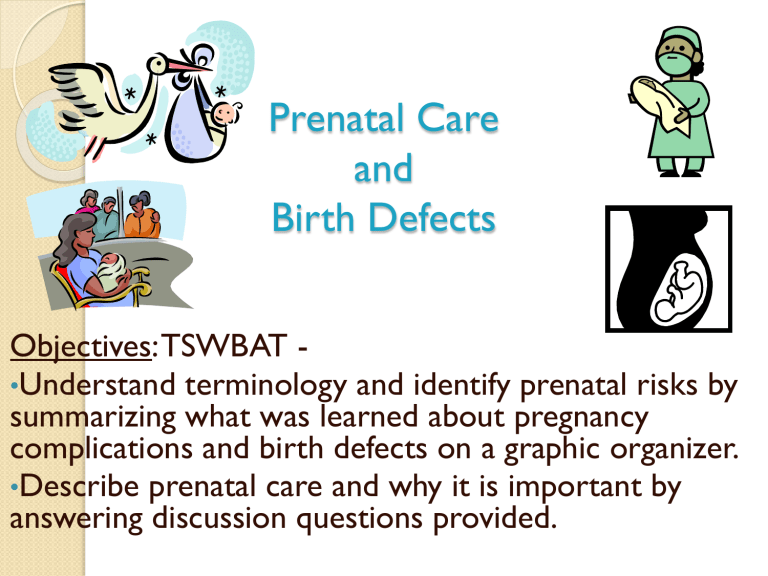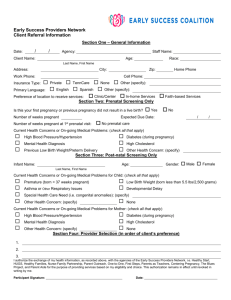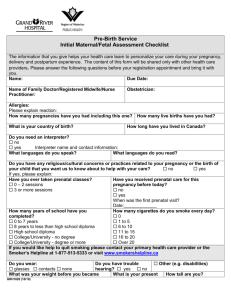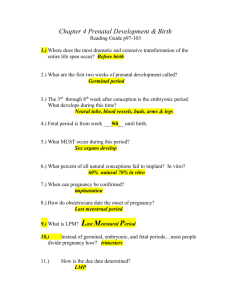Prenatal Care and Birth Defects

Prenatal Care and
Birth Defects
•
Objectives: TSWBAT -
Understand terminology and identify prenatal risks by summarizing what was learned about pregnancy complications and birth defects on a graphic organizer.
• Describe prenatal care and why it is important by answering discussion questions provided.
Prenatal Care
When a female confirms her pregnancy she should: begin prenatal care with either an obstetrician or a certified nurse midwife.
Prenatal care deals with:
Nutrition
Monitoring of weight
Due Date
Lab Tests
Prenatal Care
Obstetrician - A physician that specializes in caring for pregnant women through childbirth.
Certified Nurse Midwife – Advanced practice nurse who, in addition to providing prenatal care, specializes in the delivery of healthy babies.
Healthy Pregnancy
A pregnant woman must be very careful about what substances she takes into her body.
Things to be aware of and avoid
Medicines
Illegal drugs
Caffeine
Complications…
Premature Birth - refers to the birth of a baby before the developing organs are mature enough to allow normal postnatal survival.
Miscarriage – Spontaneous abortion, in which the female expels the embryo or fetus.
Stillbirth – The birth of a dead fetus.
Diabetes
Type 1 =
Usually diagnosed in childhood.
Body makes little or no insulin.
Daily injections of insulin are needed.
The exact cause is unknown.
Genetics, viruses, and autoimmune problems may play a role.
Diabetes
Type 2 =
More common than type 1
It makes up most of diabetes cases. usually occurs in adulthood pancreas does not make enough insulin to keep blood glucose levels normal
◦ often because the body does not respond well to insulin.
Many people with type 2 diabetes do not know they have it becoming more common due to increasing obesity and failure to exercise.
Diabetes
Gestational =
High blood glucose during pregnancy only
high risk of developing type 2 diabetes and cardiovascular disease later in life.
Spina Bifida
Malformation of the embryo.
Backbone and spinal canal do not close before birth.
In severe cases, this can result in the spinal cord and its covering membranes protruding out of an affected infant's back.
Spina bifida may also be nearly inconsequential, or may be reparable through surgery.
Cleft Palate
Malformation of the embryo around the mouth and palate .
Can be:
◦ just a small notch in the lip
◦ a complete split in the lip that goes all the way to the base of the nose
◦ on one or both sides of the roof of the mouth.
◦ the full length of the palate.
Can include misaligned teeth or change in nose shape (amount of distortion varies).
Fetal Alcohol Syndrome (FAS)
Occurs when a woman drinks alcohol during pregnancy.
FAS is entirely preventable
Because even small amounts of alcohol may be harmful, the safe decision for a pregnant woman is not to drink any alcoholic beverages.
Fetal Alcohol Syndrome (FAS)
Symptoms:
Poor growth of baby
Decreased muscle tone
Poor coordination
Heart defects
Delayed development in:
Thinking
Speech
Movement
Social Skills
FAS Facts Quiz
Fetal Alcohol Syndrome (FAS)
Video : Living with FAS
Tobacco and Pregnancy
Babies born have a greater chance of being born prematurely with low birth rates.
Tobacco and Pregnancy
◦ 1999–-2002, almost 40 million children, aged 3–19 years, or about 58% of children in this age group, were exposed to secondhand smoke.
◦ Infants who are exposed to secondhand smoke are more likely to die of SIDS compared to children not exposed.
◦ Children who are exposed to secondhand smoke are at increased risk for bronchitis, pneumonia, ear infections, more severe asthma, respiratory symptoms, and slowed lung growth.
Surfacant
Substance used to increase the chance for babies to survive premature birth.
Medication used to help infants suffering from or at great risk of respiratory distress syndrome .
A soapy material inside the lungs of adults and mature infants that helps the lung to function.
X-Rays
An environmental factor that can endanger the fetus
Generally safe during pregnancy, but there is quite a bit of controversy surrounding this issue.
Studies have been conflicting, and therefore x-rays should only be done when the benefits outweigh the risks.
X-rays can give your health care provider important and even life saving information about numerous medical conditions.
Postpartum Depression
1 in 8 women suffer from Postpartum
(after birth) depression
Symptoms can appear any time during pregnancy and the first 12 months after
Childbirth.
Questions
Which numbers listed on your sheet are 100% preventable?
Did you know anyone with one of these complications?




